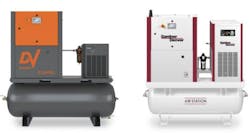Despite a Deal Flurry, M&A Watchers Say Activity Set to Slow
For a few minutes, June 30 felt like an old-fashioned Merger Monday.
At the very beginning of the week leading up to July Fourth, Parker Hannifin Corp. executives announced they’ll spend about $1 billion to add controllers and instrumentation manufacturer Curtis Instruments Inc. to their portfolio and TransDigm Group Inc. leaders said they’d agreed to pay $765 million for Simmonds Precision Products Inc., a specialist in sensing and monitoring technologies used in aerospace and defense work.
The following morning delivered more deal news: Packaging Corp. of America announced it will buy Greif Inc’s containerboard business for $1.8 billion while the team at Modine Manufacturing Co. said it will pay $65 million to add Climate By Design International its indoor air quality division.
That flurry of transactions came shortly after Eaton plc executives announced they’ll pay more than $1.5 billion for electronic controls and sensing products company Ultra PCS—a deal that was itself announced on the heels of word that auto supplier Allison Transmission Holdings Inc. will buy Dana Inc.’s off-highway business.
The June 30/July 1 headlines were followed early last week by word from Wabtec Corp. that it is buying train detection technology venture Frauscher Sensor Technology Group for about $790 million.
So is this a manufacturing M&A wave building?
Most market watchers and company advisors say no, even if activity in a few other prominent sectors—think of anything related to artificial intelligence and/or data centers—has remained hot. They don’t see a big swing upwards from activity in the first five months of this year, when PricewaterhouseCoopers analysts say the value of deals (excluding those worth more than $5 billion) in the automotive, engineering and manufacturing sectors fell nearly 9% from 2024 while the number of transactions fell more than 5%.
Among the reasons for stagnation is that the broader industrial sector hasn’t been able to show consistent growth for several years now. But more specifically, too many factors—most notably tariff-related input costs and high interest rates—remain too uncertain for potential deal makers to truly commit a mountain of money or much of their attention.
Austan Goolsbee, the president of the Federal Reserve Bank of Chicago, last week told the Wall Street Journal new tariff turmoil amounts to “throwing more dirt back in the air.” And he’s far from alone among notable economic names to link tariffs to inflation.
“Tariff hikes are typically stagflationary shocks—they simultaneously increase the probability of an economic slowdown while putting upward pressure on prices,” Torsten Sløk, chief economist of investment firm Apollo, wrote in his recent mid-year economic update. “In our view, the current tariff regime increases the chance of a U.S. recession to 25% over the next 12 months.”
Making the Case
Still, it’s worth pointing out that PwC’s data (available here) show many deals—the negotiations for which likely started in late 2024 or early this year—are still being done, something that seemed a rather distant prospect amid the tariff chaos of early spring. It’s likely we see a dip going forward, though: In a May report, leaders at KPMG said many of their clients were moving more slowly on major strategic decisions and that “prospective dealmaking has significantly slowed.”
Investor sentiment is helping pull talks over the finish line for public companies by giving them strong currencies: The Industrial Select Sector SPDR Fund (Ticker: XLI), viewed as a benchmark for U.S. manufacturing, is up 14% year to date and closed July 11 less than 1% from its 52-week high. And on the flip side: Many private-equity firms that invested five years ago or more are growing hungrier to sell and return capital to their investors.
An expected lowering of interest rates could help that dynamic, Sløk and his team at Apollo say.
“If the Fed decides to cut interest rates later this year, we could see a new wave of deals as, on the one hand, sponsors seek to deploy capital raised in the past three years and, on the other, managers may be willing to part with existing investments as cheaper borrowing costs may bolster valuations,” they wrote recently.
Such a movement will help offset the smaller pipeline KPMG’s pros have seen since spring. In the meantime, they say, smart management teams are buying straw hats in winter and lining up their next round of deals. They’re not crawling into foxholes and hiding out while the market is unsettled.
“While there are definitely fewer deals and some are deferring big strategic decisions, what seems more surprising is the number of new deals being contemplated by our clients, independent of the uncertainty in the market,” Todd Dubner, the firm’s national deal advisory and strategy leader for industrial manufacturing, said recently on LinkedIn.
Sheon Karol, a senior advisor to private-equity firm West Lane Partners, is of the same mind. Greener pastures are ahead, he told IndustryWeek, and now is a good time for strong leadership teams to look to grow because others in their markets might be fearful. Picking up well-run businesses when the near-term outlook is cloudy is a solid formula for long-term success, he said.
“To buy at a discount, you need to buy at a moment where a product is undervalued, where a product will become more valuable over time,” Karol said, pointing specifically to businesses feeding into broad infrastructure spending trends. “There’s pent-up spending that has to take place.”
About the Author
Geert De Lombaerde
Senior Editor
A native of Belgium, Geert De Lombaerde has been in business journalism since the mid-1990s and writes about public companies, markets and economic trends for Endeavor Business Media publications, focusing on IndustryWeek, FleetOwner, Oil & Gas Journal, T&D World and Healthcare Innovation. He also curates the twice-monthly Market Moves Strategy newsletter that showcases Endeavor stories on strategy, leadership and investment and contributes to other Market Moves newsletters.
With a degree in journalism from the University of Missouri, he began his reporting career at the Business Courier in Cincinnati in 1997, initially covering retail and the courts before shifting to banking, insurance and investing. He later was managing editor and editor of the Nashville Business Journal before being named editor of the Nashville Post in early 2008. He led a team that helped grow the Post's online traffic more than fivefold before joining Endeavor in September 2021.




